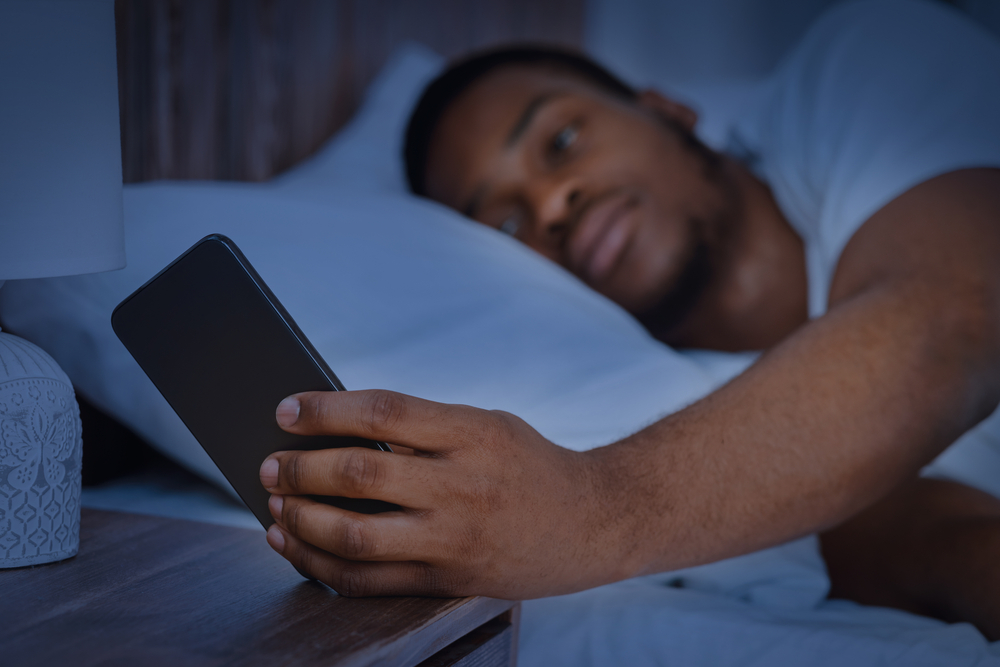That innocent scroll through social media right before you close your eyes might be doing more than just stealing an extra half hour of your night. It could be transforming your dreamscape into a bizarre digital funhouse that leaves you waking up confused, unsettled, and surprisingly unrested. Your pre-sleep phone habit isn’t just keeping you up later—it’s actually reprogramming your dreams in ways science is just beginning to understand.
The sleep thieves in your hand
We all know the basic problem with bedtime scrolling—the bright blue light tricks your brain into thinking it’s still daytime, suppressing melatonin production and making it harder to fall asleep. But that’s just the surface-level issue, the one everyone talks about. The deeper and more fascinating problem happens after you finally do drift off, when your dreams take on distinctly different qualities than they would have without that final digital binge.
Your smartphone creates a perfect storm of dream-disrupting elements. There’s the light exposure, yes, but also the rapid-fire content consumption, the emotional roller coaster of seeing everything from your ex’s vacation photos to disturbing news headlines, and the fragmented attention pattern that comes from jumping between apps, videos, and messages. This digital cocktail doesn’t just disappear when you finally put the phone down—it filters directly into your dream content and quality.
When you expose your brain to this kind of stimulation right before sleep, you’re essentially loading up your mental processing queue with fragmented, emotionally charged content precisely when your brain is preparing to sort through the day’s experiences. It’s like dumping a jigsaw puzzle on the floor right as someone’s trying to organize their desk.
The dream fragmentation effect
One of the most common effects of pre-sleep scrolling is increased dream fragmentation. Regular scrollers report dreams that change scenes more frequently, lack coherent narratives, and feel more disjointed than their normal dreams. This fragmentation mirrors the way we consume content on our phones—quick hits of unrelated information that our brains never fully process before moving to the next thing.
Think about how you use your phone before bed. In the span of 15 minutes, you might check tomorrow’s weather, read half an article about climate change, watch three short videos of strangers dancing, scroll past dozens of food photos, and catch a glimpse of a disturbing news headline. Your brain doesn’t have time to emotionally process any of these things before sleep, so that unfinished business gets worked into your dreams in chaotic ways.
This creates dreams that feel like someone constantly changing the channel—you’re at work, then suddenly you’re in your childhood home, then you’re being chased by a celebrity you just saw on Instagram. Your brain is desperately trying to make connections between these disparate elements, creating bizarre narratives that leave you feeling mentally exhausted rather than refreshed.
The emotional amplifier
Social media is engineered to trigger emotional responses—that’s what keeps us scrolling. When those emotions get stirred up right before sleep, they don’t just disappear. Instead, they become super-charged in our dreams, often in ways that feel unsettling and out of proportion.
That mildly annoying comment you read right before bed might manifest as a full-blown confrontation in your dreams. The cute puppy video that made you smile could transform into an overwhelming emotional reunion with a childhood pet. The brief pang of jealousy from seeing a friend’s vacation photos might become a detailed dream narrative about betrayal and abandonment.
This emotional amplification happens because during REM sleep, the prefrontal cortex—the brain region responsible for logical thinking and emotional regulation—takes a back seat, while the amygdala, which processes emotions, remains active. Without your logical brain to keep things in perspective, emotions experienced during dreams can feel extraordinarily intense and irrational.
The alert-state hangover
Scrolling puts your brain in a heightened state of alertness that doesn’t just switch off when you put down your phone. This alert state carries over into your sleep, creating what sleep researchers call “hyperarousal”—a condition where parts of your brain remain unusually active even when you should be deeply relaxed.
This hyperarousal manifests in dreams that feel unnaturally vivid, detailed, and often stressful. Many people report dreams where they’re trying to complete impossible tasks, solve complex problems, or navigate high-pressure social situations—all symptoms of a brain that hasn’t fully downshifted from its daytime vigilance.
The content itself might not seem directly related to what you were scrolling, but the mental state carries over. Your dream might involve frantically trying to pack for a trip you’re not prepared for, searching for something important you’ve lost, or trying to meet an impossible deadline. These anxiety-tinged scenarios reflect your brain’s inability to fully disengage from its alert, problem-solving mode.
The narrative disruption
Dreams play a crucial role in consolidating memories and processing emotions. Under normal circumstances, your brain weaves daily experiences into dream narratives that help you make sense of your life and relationships. But pre-sleep scrolling floods your brain with disconnected information that has nothing to do with your actual life experiences.
Regular scrollers report dreams that feel less personally meaningful and more like abstract, fragmented reflections of content they’ve consumed. Rather than dreaming about that conversation you had with your boss or the project you’re worried about, you might dream about random strangers from TikTok or scenarios inspired by news headlines that have no connection to your life.
This disruption of natural dream narratives robs you of the emotional processing that healthy dreaming provides. You wake up having technically slept, but without the psychological benefits that properly structured dreams offer—leaving you feeling emotionally unresolved despite getting your hours in.
The reality blur
Perhaps most unsettling is how regular pre-sleep scrolling can begin to blur the lines between digital content and your actual memories. Your brain struggles to distinguish between experienced events and observed content, especially when that content triggers emotional responses.
People who scroll heavily before bed often report dreams where they’re uncertain if they’re remembering something that actually happened or something they just saw online. This memory confusion doesn’t always resolve upon waking—leading to a subtle but persistent sense of disconnection from your own experiences.
This phenomenon helps explain why heavy social media users sometimes feel a strange emotional detachment from their own lives. When your dreams constantly incorporate digital content rather than processing your lived experiences, your sense of a coherent personal narrative begins to fragment.
The solution sanctuary
Creating a digital buffer zone before sleep can dramatically improve dream quality. Sleep experts recommend putting away all screens at least 30-60 minutes before bedtime—not just because of the blue light, but to give your brain time to process the day’s actual events rather than the last dozen things you scrolled past.
This buffer doesn’t have to be boring. Reading a physical book, gentle stretching, meditation, journaling, or even just quiet conversation can all help your brain transition from its fragmented, alert state to a more integrated, reflective mode that supports healthy dream cycles.
Many reformed scrollers report that their dreams become not just less chaotic but actually more useful when they establish this buffer zone. Their dreams return to processing meaningful life events, working through genuine emotional challenges, and occasionally providing creative insights or solutions to problems—all functions that healthy dreaming should serve.
The dream intention reset
Beyond simply avoiding screens, you can actively influence your dream content through a practice sleep researchers call “dream incubation.” As you’re falling asleep, consciously direct your thoughts toward what you’d like to dream about—a pleasant memory, a creative project, or even just calm, peaceful scenery.
This intentional focus works particularly well when paired with visualization. Spending a few minutes imagining a specific scene or scenario activates the same neural networks that will remain active during sleep, making those elements more likely to appear in your dreams.
The practice sounds simple, but it can be remarkably effective at counteracting the chaos that scrolling introduces to your dreamscape. Many people find that even just a week of replacing phone time with intentional dream preparation leads to noticeably more coherent, pleasant, and restful dreams.
The rhythm restoration
Our natural sleep cycles follow patterns tied to daylight and darkness—patterns that phone use directly disrupts. Restoring alignment with these natural rhythms can have profound effects on dream quality and overall sleep satisfaction.
Try synchronizing your bedtime routine with the actual sunset for a week, even if that means going to bed earlier than usual. As daylight diminishes, begin winding down activities, dimming lights, and engaging in progressively more relaxing behaviors. This gradual transition signals to your brain that it’s time to shift from active processing to restorative sleep.
Many people who adopt this sunset-aligned approach report that their dreams become not just less chaotic but also more vivid in a pleasant way—rich with detail and emotion without being overwhelming or fragmented. This improvement likely stems from better alignment with natural circadian rhythms that governed human sleep for thousands of years before smartphones existed.
The dream-friendly alternatives
If completely eliminating pre-sleep phone use feels too challenging, consider transitioning to activities that support healthy dream states rather than disrupting them. Certain kinds of content are less likely to fragment your dream landscapes than others.
Slow-paced, calming content without jarring transitions or emotionally provocative elements can help ease your brain toward sleep without loading it with processing tasks. Nature documentaries with their slow pacing and calm narration, ambient music applications, or meditation guidance can serve as stepping stones away from scrolling without requiring cold-turkey abandonment of technology.
Audio-only options like podcasts or audiobooks allow you to put the screen away while still consuming content. Many people find that listening to familiar, soothing voices discussing interesting but not emotionally charged topics helps them transition toward sleep without triggering the dream disruption that visual scrolling causes.
The dream diary discovery
One of the most powerful tools for understanding how scrolling affects your dreams is keeping a simple dream journal. Each morning, before checking your phone, jot down any dreams you remember from the night before. Note whether you scrolled before sleep and for approximately how long.
After just two weeks of this practice, patterns typically emerge that make the connection between scrolling and dream quality undeniable. Most people discover that their most restorative, meaningful dreams occur on nights when they didn’t scroll, while their most chaotic, unsettling dreams follow heavy pre-sleep phone use.
This personal data collection often proves more motivating than general advice about screen time. Seeing your own dream patterns documented makes the abstract concept of “phone-induced dream disruption” concrete and personal, providing the motivation needed to change deeply ingrained habits.
By recognizing how your nighttime digital habits are rewriting your dreamscapes, you gain the power to reclaim your sleep. Your dreams aren’t just random brain static—they’re a vital psychological process that deserves protection from the chaos of endless scrolling. The next time you reach for your phone before bed, remember that you’re not just deciding how quickly you’ll fall asleep, but what kind of mental world you’ll inhabit once you do.















